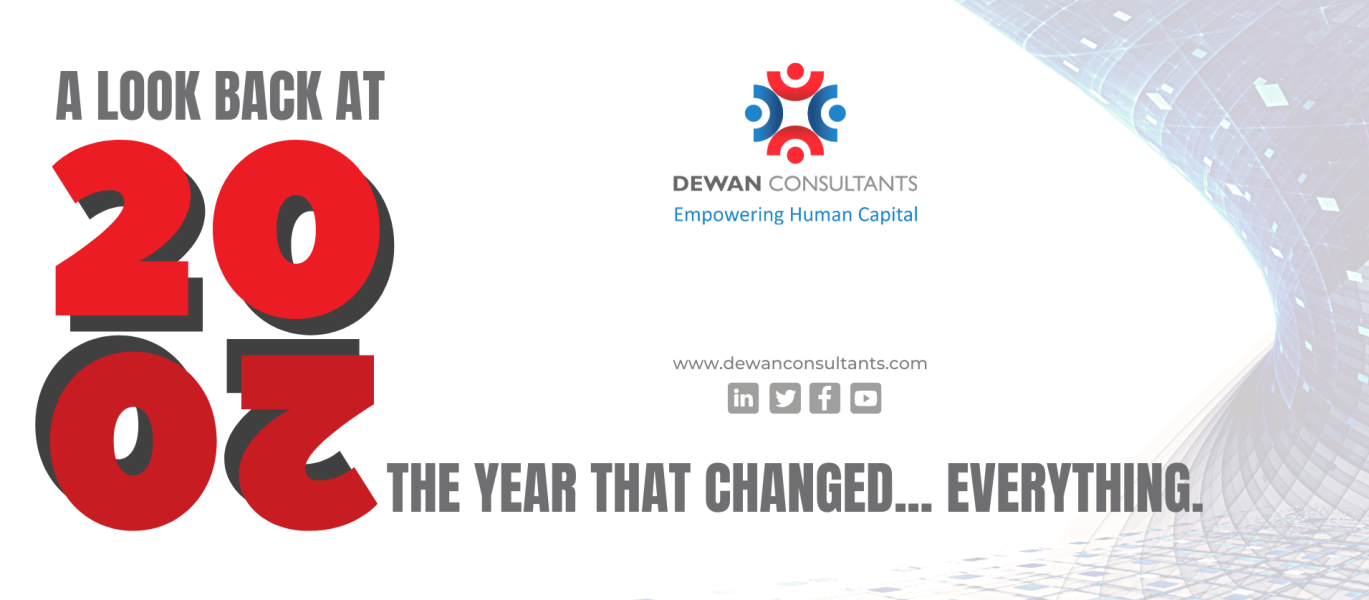 February 15, 2021
February 15, 2021

There is no denying that the dawn of 2021 ushers a renewed sense of hope and optimism. At the cusp of this annual transition, we pause to reflect on 2020 and are awestruck at how one person’s choice of lunch triggered a global domino effect with unprecedented ramifications, one that affected the entire breadth of personal, professional, socio-economic, and economic spectrums, both globally and personally.
But, it’s not all doom and gloom. As we look back, we also take stock of the accelerated advancements, the digitization, and digitalization, the workforce upskilling and reskilling, our leaders coming into their own, the now inclusivity and diversity, these little flickers of hope, as we stood in solidarity, as one, even if it was from behind our computer screens.
2020 was a year where we forged new connections, realized the undefeated nature of the human spirit and the true meaning of relentless determination.
Professionally and economically, some companies fared better than others as did countries. Some notable examples of economies that stood out include South Korea, Singapore, and Hong Kong. These, among others, such as Estonia, Taiwan, and the United Arab Emirates, have consistently been top performers in recognizing, addressing, and containing the pandemic. These countries have demonstrated both adaptability and institution-led support for innovation.
Interestingly enough, the U.S. also shows remarkable momentum for an economy of its size and complexity and comes second in digital evolution after Singapore in 2020.
Additionally, these countries also prioritized the adoption of digital consumer tools; attracted, trained, and retained digital talent; fostered digital entrepreneurial ventures, and specialized in the export of digital goods, services, or media.
Here’s a round-up of the positive outcomes of the now-not-so-novel-Coronavirus and its impact on a year that was.
Working From Home

No alt text provided for this image
One of the most significant positives that came out of the pandemic is increased reliance on and preference for working from home (WFH). Besides the convenience and elimination of commutes, the biggest benefit of WFH came in the form of increased productivity. Yes, increased productivity: it didn’t take long for everyone to realize (and for companies to monetize) what many had only suspected previously: a lot of time at the office was wasted (30%, according to one study described in Inc.) in unnecessary meetings, partaking in office politics — voluntarily or involuntarily — clock-watching, gossiping and of course the infamous coffee breaks.
Besides, forced WFH during the pandemic also brought about wider acceptance of decentralized, scattered, and outsourced workforces. Business leaders learned to trust people without having them under the same roof. It also helped them downsize office size and reduce their office expenses.
Of course, it didn’t (and it still doesn’t) work for everyone.
Employers have always wanted and looked for self-driven, self-motivated workers. For WFH to succeed, these traits became critical differentiators and must-haves for anyone wanting to work from home after the pandemic.
Housing

No alt text provided for this image
Back in 2020, millennials (those born between 1981 and 1996) had already seemingly begun questioning homeownership as a necessary graduation into adulthood. This trend toward rental-living continued at a greater pace as millennials reached their prime earning phase through the decade.
A housing trend highlighted by The Washington Post in 2019 that got reversed is down-sizing. With the increased adoption of WFH, the need for more space and increased privacy (for simultaneous Zoom calls by multiple members of a household) became obvious. Homes with home offices became the new norm. “Number of office-rooms” became part of standard home descriptions, alongside the number of bedrooms, bathrooms, and garage spaces.
Telemedicine

No alt text provided for this image
Initially, the industry got its day in the sun out of necessity. It was the only safe way to do a routine “visit” to a doctor during the pandemic. However, it didn’t take long for both patients and medical professionals to appreciate the efficiencies and safety of telemedicine consultations for most simple ailments. This growth — which a 2020 report estimated would continue at a combined annual growth rate of 15.1% between 2020 and 2027 — was further boosted by the availability and adoption of home-use diagnostic gadgets and apps capable of tracking data like medical-grade ECG, blood pressure, sugar levels, heart and lung sounds, and so on.
This trend had a material impact on the cost of healthcare for facilities and consumers. It also drove increased acceptance of cash-patients for routine check-up’s and garden-variety ailments.
Shopping And Entertainment

No alt text provided for this image
By the time the novel coronavirus pandemic shook up the world in 2020, companies like Amazon, Noon, and Flipkart had already established online retail as a formidable and existential threat to traditional brick-and-mortar retail, as Digitalcommerce360 estimated that e-commerce made up 16% of total retail sales in 2019. The pandemic simply stifled further life out of retail.
This time, it also brought down the prevalence of movie theatres and other crowded live entertainment in tightly packed settings as streaming became a bigger part of how people entertained themselves — mostly at home, with Netflix reigning supreme.
Food

No alt text provided for this image
Vegetarianism and veganism were more than mere curiosities at the start of the decade. (Eight percent of those aged 30-49 identified as vegetarian, according to 2018 Gallup data covered in Forbes.) Over the past 10 years, largely due to fears of another zoonotic pandemic like the havoc the coronavirus created in 2020, more people the world over became serious about reducing, if not entirely eliminating, animal proteins from their diets.
Of course, this had another positive impact on the general wellness of the public. Cardiovascular diseases and obesity growth slowed its growth trajectory established (in the case of obesity) over 50 years ago.
Another significant fringe benefit of this trend has been a reduction of greenhouse gases and the easing of water shortages faced by many agrarian states. According to Science (via OurWorldInData), livestock and fish farms were responsible for 31% of greenhouse gas emissions for global food production in 2018. A global army of well-meaning environmentalists couldn’t achieve this, but an invisible life-form achieved it in quick order for them.
The Much Awaited Return to the ‘New-Normal’

No alt text provided for this image
Returning businesses to operational health after a severe shutdown is extremely challenging. Most industries will need to reactivate their entire supply chain, even as the differential scale and timing of the impact of coronavirus mean that global supply chains face disruption in multiple geographies. The weakest point in the chain will determine the success or otherwise of a return to rehiring, training, and attaining previous levels of workforce productivity. Leaders must therefore reassess their entire business system and plan for contingent actions in order to return their business to effective production at pace and at scale.
The crisis reveals not just vulnerabilities but opportunities to improve the performance of businesses. Leaders need to reconsider which costs are truly fixed versus variable, as the shutting down of huge swaths of production sheds light on what is ultimately required versus nice to have. Decisions about how far to flex operations without loss of efficiency will likewise be informed by the experience of closing down much of global production. Opportunities to push the envelope of technology adoption will be accelerated by rapid learning about what it takes to drive productivity when labour is unavailable. The result: a stronger sense of what makes business more resilient to shocks, more productive, and better able to deliver to customers.
The world now has a much sharper definition of what constitutes a black-swan event. This shock will likely give way to a desire to restrict some factors that helped make the coronavirus a global challenge, rather than a local issue to be managed. Governments are likely to feel emboldened and supported by their citizens to take a more active role in shaping economic activity. Business leaders need to anticipate popularly supported changes to policies and regulations as society seeks to avoid, mitigate, and pre-empt a future health crisis of the kind we are experiencing today.
In most economies, a healthcare system little changed since its creation post–World War II will need to determine how to meet such a rapid surge in patient volume, managing seamlessly across in-person and virtual care. Public-health approaches, in an interconnected and highly mobile world, must rethink the speed and global coordination with which they need to react.
Policies on critical healthcare infrastructure, strategic reserves of key supplies, and contingency production facilities for critical medical equipment will all need to be addressed. Managers of the financial system and the economy, having learned from the economically induced failures of the last global financial crisis, must now contend with strengthening the system to withstand acute and global exogenous shocks, such as this pandemic’s impact. Educational institutions will need to consider modernizing to integrate classroom and distance learning. The list goes on.
The aftermath of the pandemic will also provide an opportunity to learn from a plethora of social innovations and experiments, ranging from working from home to large-scale surveillance. With this will come an understanding of which innovations, if adopted permanently, might provide substantial uplift to economic and social welfare—and which would ultimately inhibit the broader betterment of society, even if helpful in halting or limiting the spread of the virus.
Looking at the Finer Picture – Mental Health Care for the Returning Work Force

No alt text provided for this image
Theodore Roosevelt once said, “The more you know about the past, the better prepared you are for the future.” By examining the behavioural health impact of the Great Recession and other large-scale disasters, we can mitigate the negative impact to society from further economic loss and human suffering. Extensive research has documented the association of recessions, mass layoffs, and prolonged periods of unemployment with an increase in income inequality and devastating impact on health and life expectancy.
As governments race to contain COVID-19, it is important to know the actions society can take to mitigate the behavioural health impact of the pandemic and economic crisis. For every one dirham spent on scaling up treatment for common mental disorders, a four-dirham return can be realized in improved health and productivity.
Given the urgency of this issue, no-regrets steps for healthcare stakeholders could include the following:
In the turmoil around the economy and the coronavirus itself, society should be mindful of its collective resilience. The anxiety, stress, financial strife, grief, and general uncertainty of this time will undoubtedly lead to behavioural health crises. It is therefore important that communities seeking a “next normal” can draw from their inherent strength and compassion to recognize, treat, and support those experiencing this human toll of the COVID-19 pandemic.









